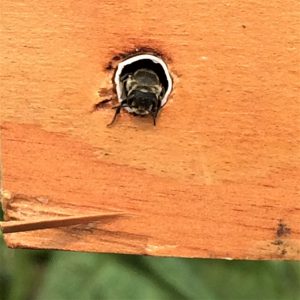Central-place foragers are animals that return to the same nest in between foraging trips, collecting their food, or food for their offspring, in an area around that nest. Animals that are not central-place foragers instead roam continuously, foraging and reproducing over a large area as they move from place to place.
All bees are central-place foragers, including honey bees, bumble bees, and solitary bees like sweat bees and leafcutter bees. Once an adult bee establishes the location of her nest, she remains there for her entire adult lifespan, foraging for pollen and nectar around that nest. For social bees, after the queen establishes the colony, all of the workers forage around the hive and return to the hive daily throughout their lives.
Other pollinators, like butterflies, moths, or flies, are not central-place foragers. These insects fly over relatively large areas, visiting flowers along the way, and laying eggs in different locations along the way. Other than the bees, most pollinating insects do not have a single nest site or colony to return home to throughout their lives.

The central-place foraging behavior has implications for bee populations and their response to disturbances like land-use change. The area over which bees can forage for pollen and nectar is generally related to their body size.
Larger bees like bumble bees may be able to fly two miles from the colony in order to find flowers. However, smaller bees, like some of the sweat bees, may only be able to fly a couple hundred meters or a quarter of a mile from the nest.
Therefore, for bees to thrive, they must be able to find both nesting sites and flowers in a relatively small area, and the flowers must be available in that area over the bee’s lifespan. Because bees cannot simply move to a better area to search for flowers after a disturbance, or when flowers are no longer in bloom, it makes them particularly susceptible to changes in the landscape.
Conserving or restoring flower-rich natural habitats, or putting in pollinator gardens, are ways to ensure that bees have adequate floral resources within their foraging ranges and throughout their foraging season.
Read more about good plants for wildlife, including bees, here and here.
 1
1
